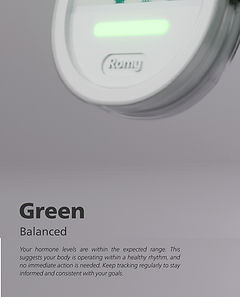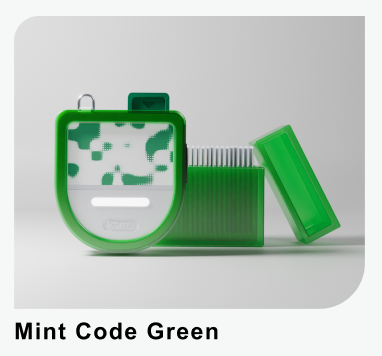ROMY
Brand Design, UX/UI, Motion, Blender/3D design
Duration: 6 months - 4th year Thesis
Year: 2025
Problem
Polycystic Ovary Syndrome (PCOS) is a hormonal disorder that affects people with ovaries. While its name suggests the presence of cysts, not all individuals with PCOS have them. The syndrome is instead identified by a combination of symptoms, including irregular periods, elevated androgen levels, and metabolic concerns such as insulin resistance.
For individuals aged 13–24, managing PCOS can be challenging, especially when faced with stigma and limited resources tailored to their needs. This age group is my primary target audience because research shows a growing demand from healthcare professionals for medical devices that are both functional and socially acceptable.
Devices can often draw unwanted attention, and stigma can come from peers and even adults. To address this, I focused on creating a design that is customizable, discreet, and approachable for young people.
Objectives
The project aimed to:
-
Develop an approachable, visually engaging resource for teenagers and young adults living with PCOS.
-
Provide tools and educational materials that make understanding and managing the condition easier.
-
Create a device and resources that appeal to both young people and the adults who support them, including parents and healthcare providers.
-
Present PCOS information in a supportive, positive, and empowering way that reduces stigma.
Solution
Using Blender, I designed a conceptual, customizable device to help track and manage PCOS-related health data. The device uses a saliva tester strip to measure three key hormones linked to PCOS: testosterone, estrogen, and cortisol. This provides accessible, at-home monitoring.
The device is paired with a youth-focused social media campaign offering digestible education, relatable content, and a sense of community. In addition, poster designs were created for parents and healthcare providers to encourage open conversations about PCOS, early management, and support strategies.
To suit each audience, social media content is casual, visually dynamic, and youth-oriented, while posters maintain a more informative, professional style appropriate for medical settings and family discussions.
Final Design Approach
The project combines product concept design, youth-focused social media, and parent or doctor-targeted print materials to bridge the information gap for young people with PCOS. By presenting the condition in a clear, empathetic, and visually appealing way, the campaign supports early understanding and empowers young people to take an active role in their health.
The design language is positive, customizable, and accessible, helping to break down stigma while fostering open dialogue between patients and their support networks.














